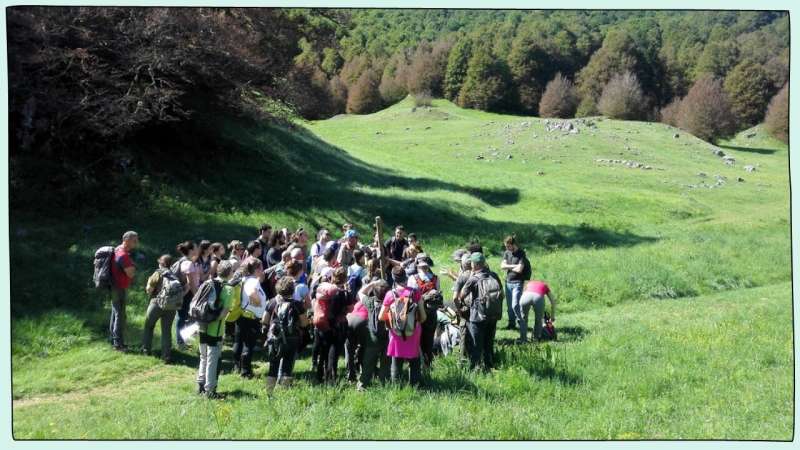A comparison of two bio-geographical regions in Italy reveals differences in the perception of ecotourism

A new study led by the Landscape Ecological Forest Planning Lab at University of Tuscia (Viterbo, Italy) realized in cooperation with the alpine detachment of the University of Milan (UNIMONT) and published in the Journal of Ecotourism assessed similarities and differences in the environmental dimension of ecotourism in two different bio-geographical regions (Alpine temperate vs Mediterranean biomes) in protected areas of Italy.
Environmental and tourism management issues were investigated through the eyes of accredited hiking guides operating in selected National and Regional Parks in the Alps and Apennine. Overall, interviewees agreed on the strategic role protected areas are playing in protecting and conserving the natural environment despite increasing tourism flows. Differences emerged when guides were asked to assess environmental management practices and tourists' motivations. Results highlight features and perceptions of ecotourism in the investigated bio-geographical regions and the role properly trained hiking guides can play in prompting ecotourism, environmental sustainability and conservation strategies.
Nature-based tourism is increasing worldwide. That is because many urban dwellers, spending much of the year in crowded and polluted cities, desire a peaceful and healthy environment to enjoy their vacations. And what is more peaceful, healthy, and beautiful than a protected area? Of course, tourism represents an opportunity for protected areas to produce incomes for local communities. However, increased tourism flows risk threatening nature conservation in protected areas. This especially happens in the case of unregulated tourism or in the case of incorrect tourists' behavior. Ecotourism is defined as a type of nature-based tourism in which benefits are shared by nature, society, and the economy in an equal measure. But how do people working and visiting natural destinations perceive these three dimensions?
A new study published in the Journal of Ecotourism analyzed perceptions and attitudes towards the environmental dimension of ecotourism in protected areas by interviewing accredited hiking guides. In the framework of the National joint project "Italian Mountain Lab," led by University of Milano (UNIMONT) in partnership with the University of Tuscia (Viterbo, Italy), Piemonte Orientale (Eastern Piedmont) and Calabria (Rende), the study explored the environmental dimension of tourism in protected areas by interviewing accredited hiking guides. Hiking guides represent a bridge between many stakeholders, like tourists, park managers, and local communities. Two bio-geographical regions were chosen for comparison: the summer-rain (temperate, i.e. the Alps) region and the summer-dry (Mediterranean; i.e. the Apennines) region. These two regions have strong differences in their environmental and sociocultural properties.
In fact, the main finding was the difference in the way interviewees assessed the management of forests in protected areas. Guides from the Mediterranean areas were more concerned with the impact of harvesting activities while in the temperate zone guides appeared more accustomed to forestry. This pattern finds an explanation in both the sociocultural and the environmental features of the two regions, according to the authors. "In the temperate region forests are usually managed as high forests while in the Mediterranean areas coppicing is still today very diffuse," said Gianluca Piovesan, professor at the University of Tuscia. "However, the Apennines are also characterized by patches of old-growth forests such as the 'UNESCO World Heritage beech forests'; their important role in conservation biology and climate change mitigation can be communicated to people by competent hiking guides."
Because of coppicing and forest degradation, most forests in the Mediterranean likely appear less "vigorous" than forests in the Alps and that can be the reason why local guides view forestry and forest cutting activities differently in the two regions. But this is not the only difference between the two regions the study highlighted. Differences in the type of tourism preferred by tourists also stood out between the two regions. In the temperate area, most of the tourism is linked to outdoor activities, while in the Mediterranean rural areas local gastronomy and cultural heritages represent the main attractions. "Again, environmental features can be the reason behind such a difference," explains Jordan Palli, Ph.D. student at the University of Tuscia and leading author of the study. "The temperate area is characterized by mild temperatures in summer and snow in winter, allowing for a variety of outdoor activities all year round. In the Mediterranean protected areas, summer is hot and dry, thus the main tourist attractions are ancient towns with a strong cultural identity and peculiarities."
Beyond all the differences highlighted by hiking guides operating in two different biogeographic regions, there was an overall agreement on the role protected areas are playing in conserving biodiversity and the ecological integrity of natural landscapes. Despite the different views and cultural influences of people belonging to the two regions, almost everyone acknowledged the efforts of park governance in minimizing the impact of tourism in protected areas.
More information: Palli et al., The environmental dimension of ecotourism in Italian protected areas: a comparison of two bio-geographical regions based on the assessment of accredited hiking guides, Journal of Ecotourism (2022). doi.org/10.1080/14724049.2022.2080215
Provided by University of Tuscia





















